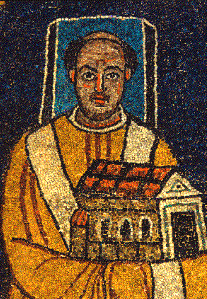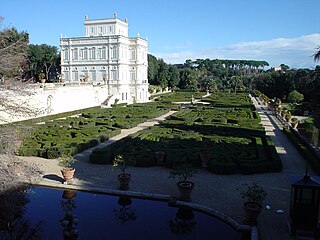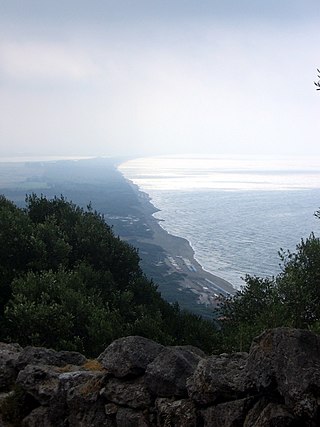
Pope Paschal I was the bishop of Rome and ruler of the Papal States from 25 January 817 to his death in 824.

Rosamond Deborah McKitterick is an English medieval historian. She is an expert on the Frankish kingdoms in the eighth and ninth centuries AD, who uses palaeographical and manuscript studies to illuminate aspects of the political, cultural, intellectual, religious, and social history of the Early Middle Ages. From 1999 until 2016 she was Professor of Medieval History and director of research at the University of Cambridge. She is a Fellow of Sidney Sussex College and Professor Emerita of Medieval History in the University of Cambridge.

Trastevere is the 13th rione of Rome: it is identified by the initials R. XIII and it is located within Municipio I. Its name comes from Latin trans Tiberim, literally 'beyond the Tiber'.
Elizabeth Mary Jeffreys was a British scholar of Byzantium. She was Bywater and Sotheby Professor of Byzantine and Modern Greek Language and Literature, University of Oxford, and a Professorial Fellow of Exeter College, Oxford, 1996–2006.

A spolia is a stone taken from an old structure and repurposed for new construction or decorative purposes. It is the result of an ancient and widespread practice whereby stone that has been quarried, cut and used in a built structure is carried away to be used elsewhere. The practice is of particular interest to historians, archaeologists and architectural historians since the gravestones, monuments and architectural fragments of antiquity are frequently found embedded in structures built centuries or millennia later. The archaeologist Philip A. Barker gives the example of a late Roman period tombstone from Wroxeter that could be seen to have been cut down and undergone weathering while it was in use as part of an exterior wall and, possibly as late as the 5th century, reinscribed for reuse as a tombstone.
Caroline Astrid Bruzelius is an American art historian and expert in medieval architecture. She is the Anne M. Cogan Professor of Art and Art History at Duke University. In 2020 she was elected to the American Philosophical Society.

Christopher John Wickham is a British historian and academic. From 2005 to 2016, he was the Chichele Professor of Medieval History at the University of Oxford and Fellow of All Souls College, Oxford; he is now emeritus professor. He had previously taught at the University of Birmingham from 1977, rising to be Professor of Early Medieval History from 1997 to 2005.
Malcolm Charles Barber is a British scholar of medieval history, described as the world's leading living expert on the Knights Templar. He is considered to have written the two most comprehensive books on the subject, The Trial of the Templars (1978) and The New Knighthood: A History of the Order of the Temple (1994). He has been an editor for The Journal of Medieval History and written many articles on the Templars, the Cathars, various elements of the Crusades, and the reign of Philip IV of France.

Monteverde is an urban zone of the quarter Gianicolense in Rome, Italy. It is located just outside the Aurelian walls, south of the Janiculum hill and southwest of Trastevere. Monteverde means green mountain and is named after a hill upon which the zone is located and which is not part of the classical seven hills of Rome.

Villa Magna is a large imperial ancient Roman villa near the modern town of Anagni, in Lazio, central Italy. The site lies in the Valle del Sacco some 65 km south of Rome, at the foot of the Monti Lepini, directly under the peak known as Monte Giuliano. The villa was excavated between 2006 and 2010.
Neil Christie is a British archaeologist and historian. He is professor of archaeology at the University of Leicester.
Elizabeth Barringer Fentress is a Roman archaeologist who specialises in Italy and North Africa. She has collaborated on the excavation of numerous sites in the Western Mediterranean and published their results. She is also the originator and scientific director of the online database of excavations in Italy, Bulgaria and elsewhere Fasti Online (www.fastionline.org), and editor of its journal Fasti Online Documents & Research (FOLD&R). In 2021 she was awarded the Archaeological Institute of America's 2022 gold medal for distinguished archaeological achievement.
Paul Magdalino is a British Byzantinist who is Bishop Wardlaw Professor (Emeritus) of Byzantine History at the University of St Andrews. He received the 1993 Runciman Award for his monograph on the reign of Manuel I Komnenos (1143–1180), which challenged Niketas Choniates' negative appraisal of the ruler.
Caroline Vout is a British classicist and art historian. As of 2019 she is a Professor in classics at the University of Cambridge and a fellow of Christ's College. In 2021 she became Director of the Museum of Classical Archaeology, Cambridge.
Vanessa Harding is professor of London history at Birkbeck College, University of London. Her research has focused on death and burial in London and Paris and she has written widely on the subject in academic journals and in book form.
Carol Symes is an American medieval historian at the University of Illinois at Urbana-Champaign. Symes founded the Education Justice Project's Theatre Initiative and directed a full-length production of William Shakespeare's The Tempest at Danville Correctional Center in 2013. She is also the executive editor of the academic journal The Medieval Globe."
Julia Steuart Barrow, is an English historian and academic, who specialises in medieval and ecclesiastical history. Since 2012, she has been Professor in Medieval Studies at the University of Leeds and previously served (2012–16) as the Director of the University's Institute for Medieval Studies.
Annalisa Marzano, FRHistS FSA, MAE is an Italian-American archaeologist and academic. She is Professor of Classical Archaeology at the University of Bologna and has been Professor of Ancient History at the University of Reading in England. She specializes in Roman social and economic history.
Isabella Lazzarini is a medieval historian. Her research interests focus on the political, social, and cultural history of late medieval Italy, with an emphasis on Renaissance diplomacy, the growth of different political languages in documentary sources, and - more recently - gender studies.








